The Myopia and Presbyopia Treatment Market is estimated to be valued at USD 22.9 billion in 2025 and is projected to reach USD 51.7 billion by 2035, registering a compound annual growth rate (CAGR) of 8.5% over the forecast period.
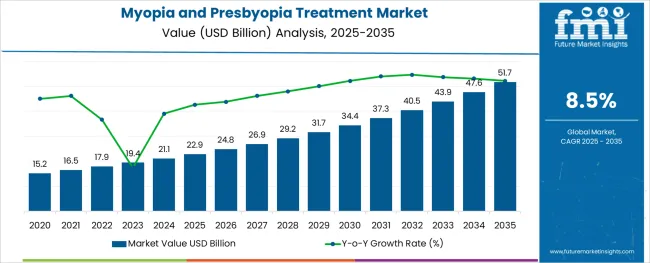
The myopia and presbyopia treatment market is expanding steadily, driven by the increasing prevalence of vision disorders across all age groups. Growing awareness of eye health and vision correction options has encouraged more individuals to seek timely treatment. Advances in ophthalmic technology and diagnostics have improved early detection and customized treatment plans for both myopia and presbyopia.
Aging populations, urban lifestyles, and increased screen time have contributed to rising rates of these refractive errors globally. Healthcare providers are adopting a combination of traditional and innovative therapies to address the diverse needs of patients.
Public health initiatives promoting regular eye exams and preventive care have also supported market growth. The market outlook remains positive with continuous product development aimed at improving visual acuity and patient comfort. Segmental growth is expected to be driven by Corrective treatment in myopia and Prescription Lenses in presbyopia due to their broad acceptance and clinical effectiveness.
The market is segmented by Myopia Treatment Type and Presbyopia Treatment Type and region. By Myopia Treatment Type, the market is divided into Corrective, Surgical, and Drugs. In terms of Presbyopia Treatment Type, the market is classified into Prescription Lenses, Contact Lenses, Intraocular Lenses, and Refractive Surgery. Regionally, the market is classified into North America, Latin America, Western Europe, Eastern Europe, Balkan & Baltic Countries, Russia & Belarus, Central Asia, East Asia, South Asia & Pacific, and the Middle East & Africa.
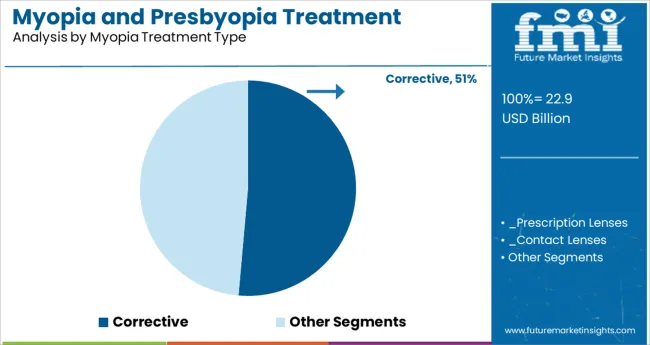
The Corrective treatment segment is expected to hold 51.4% of the myopia treatment market revenue in 2025, maintaining its position as the dominant treatment approach. This segment’s growth has been supported by the widespread use of corrective lenses and contact lenses which provide effective vision correction for myopia.
Eye care professionals continue to recommend corrective methods as the primary treatment due to their accessibility and non-invasive nature. Advances in lens technology including thinner, lighter, and anti-reflective coatings have increased patient adoption.
The ease of customization and the ability to adjust prescriptions over time have made corrective treatments highly preferred among patients. With the ongoing increase in myopia prevalence especially in younger populations, corrective treatment remains the cornerstone of myopia management.
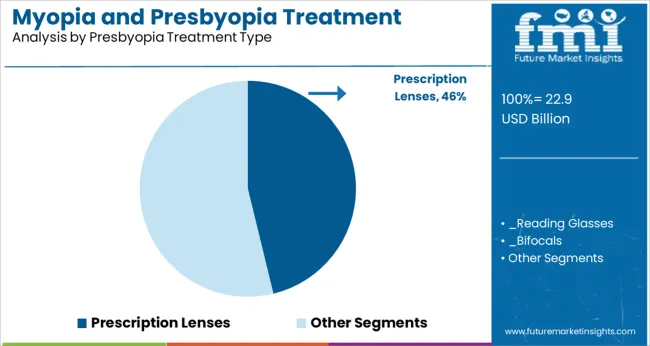
The Prescription Lenses segment is projected to contribute 46.2% of the presbyopia treatment market revenue in 2025, establishing itself as the leading treatment option. Prescription lenses, including bifocals, trifocals, and progressive lenses, have been widely adopted due to their ability to address age-related loss of near vision effectively.
Eye care specialists have favored these lenses for their flexibility in correcting varying degrees of presbyopia while allowing for clear distance vision. Continuous improvements in lens materials and design have enhanced comfort and aesthetics, encouraging more patients to choose prescription lenses over surgical alternatives.
Increasing life expectancy and the desire for improved quality of life have driven demand for prescription lenses globally. As non-invasive treatment options remain preferable to many patients, the Prescription Lenses segment is expected to sustain its leadership in presbyopia management.
On account of modern day breakthroughs in ocular lenses, it is anticipated the emerging trends in myopia and presbyopia treatment services would be instrumental in popularizing the market.
Internationally, there is a huge surge in the need for treatment choices including contact, concave, or prescription lenses that is anticipated to strengthen the global demand for myopia and presbyopia treatment facilities. The healthcare sector of various nations are also concentrating on enhancing patient flow, and as a result, they are also thinking about expanding the number of myopia and presbyopia treatment clinics.
Amongst the most cutting-edge methods for treating presbyopia is presbyLASIK OR multifocal LASIK that is anticipated to steer the myopia and presbyopia treatment market future trends ahead. However, despite the convenience of modern day LASIK surgeries, the myopia and presbyopia treatment market opportunities is also expected to strengthen for patients experiencing dry eyes condition.
Untreated presbyopia is one of the main issues that will have a significant limiting effect on the global myopia and presbyopia market. Many individuals still don't understand the aetiology of presbyopia, which leads to delayed diagnoses and less adoption of myopia and presbyopia treatment services.
Hardly two corneal inlays have been given approval to treat presbyopia at this time posing as a major restraint for the overall myopia and presbyopia market growth. However, the myopia and presbyopia market key trends and opportunities is anticipated to be aided by an expanding product portfolio and an increase in active innovations in the coming days.
Over the years of myopia and presbyopia treatment market adoption trends, the typical recovery period for ocular procedures has been drastically shortened, thanks to cutting-edge technological solutions.
In conformity with the myopia and presbyopia market statistics, the sector with the highest revenue share by the end of year 2024 accounting for more than 30% is the single prescription lenses. Reason being, in recent years myopia treatment is getting more common in emerging nations with the rising need for corrective lenses. The patient base has expanded considerably, which is helping to boost the myopia and presbyopia market size by contribution of the single prescription lenses market segment.
On the other hand, the popularity of the surgical procedures is being influenced by its attributes including minimally invasiveness, precision, and speed. Consequently, encouraging the demand for myopia and presbyopia treatment services for this segment. During the projection period of 2025 to 2035, there will likely be an upward turn in myopia ad presbyopia market trends and forecast owing to increasing popularity of surgery segment with the readily available cutting-edge equipment and dropping service prices.
On the report of myopia and presbyopia treatment market survey until 2024, the most significant revenue share more than 25% was captured by prescription lenses segment. Additionally, bifocal, multifocal, monovision, and modified monovision contact lenses fall within these categories constituting the sub-segments covered by this myopia and presbyopia market analysis report.
Presbyopia can be effectively treated using conductive keratoplasty surgery, LASIK, LASEK, and PRK, among other refractive surgical techniques that have started contributing to the myopia and presbyopia market growth remarkably in recent times. The surgical procedure segment or LASIK is extensively used to cure presbyopia in high income countries.
Therefore, it is anticipated that the rapid spread of these presbyopia treatment options and growing preference for LASIK surgery would promote the all-inclusive myopia and presbyopia treatment business throughout the course of the projection period.
All things considered, due to the rising popularity of correcting presbyopia, the progressive multifocal section is anticipated to see the quickest growth over the course of the projected period. Additionally, throughout the forecast period, multifocal sub segments including those with photochromic lenses and anti-reflexive coatings are anticipated to drive the overarching myopia and presbyopia market growth
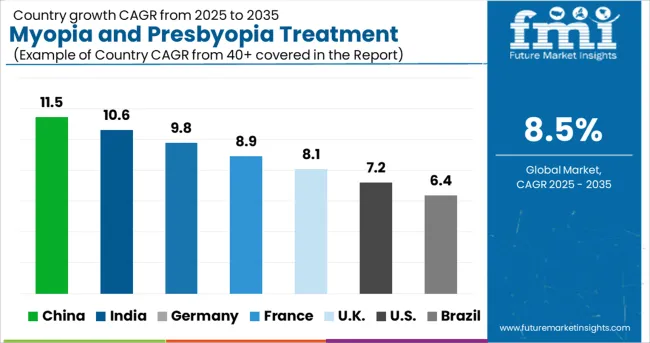
Owing to the accessibility of cutting-edge technologies for managing the various targeted myopia treatment types, as well as the presence of numerous market players, North America holds the leading position in the overall market with a capitalization of over 20.0%. And therefore, this region, particularly USA myopia and presbyopia treatment market is anticipated to maintain its dominance over the course of the forecast period.
On a similar note, presbyopia affects around 128 Million individuals in the United States only. And one-third of these people come under above 50 years age group bracket.
Due to the enlarging senior population count, the high prevalence of myopia-related eye treatments, and the rise in healthcare services, the Asia Pacific region is anticipated to see the sharpest growth in myopia and presbyopia treatment market trends throughout the projected period.
The market for myopia and presbyopia treatments in the regional market is anticipated to be driven by consumers' improving understanding of focused myopia therapy. Additionally, the regions comprising East Asia, South Asia, and Southeast Asia have the highest rates of vision problems that amounts to more than twice as many cases as other areas.
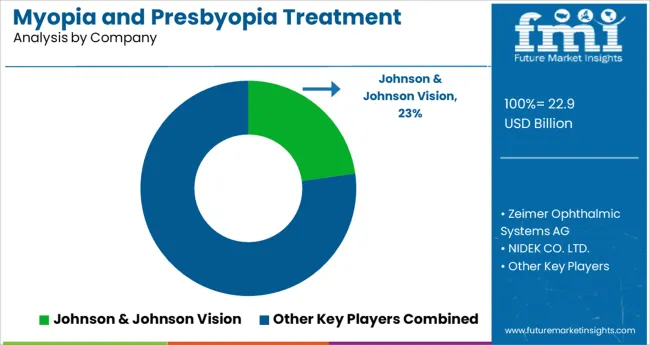
Myopia and presbyopia treatment market participants are concentrating on implementing growth initiatives, such as improvements to current technology, introduction of effective procedures, and consolidations. Myopia and presbyopia market leaders are also planning for investments in R&D to facilitate early diagnosis and create effective and speedy operating approaches to guarantee field uniqueness and solidify their market position.
Major myopia and presbyopia treatment companies like Johnson & Johnson, Essilor, and Zeimer Ophthalmic Systems AG are increasing their partnerships to create cutting-edge methodologies and therapeutic approaches to deliver better and more effective therapy for myopia and presbyopia patients.
Recent Developments in Global Myopia and Presbyopia Treatment Market
The global myopia and presbyopia treatment market is estimated to be valued at USD 22.9 billion in 2025.
It is projected to reach USD 51.7 billion by 2035.
The market is expected to grow at a 8.5% CAGR between 2025 and 2035.
The key product types are corrective, _prescription lenses, _contact lenses, surgical and drugs.
prescription lenses segment is expected to dominate with a 46.2% industry share in 2025.






Our Research Products

The "Full Research Suite" delivers actionable market intel, deep dives on markets or technologies, so clients act faster, cut risk, and unlock growth.

The Leaderboard benchmarks and ranks top vendors, classifying them as Established Leaders, Leading Challengers, or Disruptors & Challengers.

Locates where complements amplify value and substitutes erode it, forecasting net impact by horizon

We deliver granular, decision-grade intel: market sizing, 5-year forecasts, pricing, adoption, usage, revenue, and operational KPIs—plus competitor tracking, regulation, and value chains—across 60 countries broadly.

Spot the shifts before they hit your P&L. We track inflection points, adoption curves, pricing moves, and ecosystem plays to show where demand is heading, why it is changing, and what to do next across high-growth markets and disruptive tech

Real-time reads of user behavior. We track shifting priorities, perceptions of today’s and next-gen services, and provider experience, then pace how fast tech moves from trial to adoption, blending buyer, consumer, and channel inputs with social signals (#WhySwitch, #UX).

Partner with our analyst team to build a custom report designed around your business priorities. From analysing market trends to assessing competitors or crafting bespoke datasets, we tailor insights to your needs.
Supplier Intelligence
Discovery & Profiling
Capacity & Footprint
Performance & Risk
Compliance & Governance
Commercial Readiness
Who Supplies Whom
Scorecards & Shortlists
Playbooks & Docs
Category Intelligence
Definition & Scope
Demand & Use Cases
Cost Drivers
Market Structure
Supply Chain Map
Trade & Policy
Operating Norms
Deliverables
Buyer Intelligence
Account Basics
Spend & Scope
Procurement Model
Vendor Requirements
Terms & Policies
Entry Strategy
Pain Points & Triggers
Outputs
Pricing Analysis
Benchmarks
Trends
Should-Cost
Indexation
Landed Cost
Commercial Terms
Deliverables
Brand Analysis
Positioning & Value Prop
Share & Presence
Customer Evidence
Go-to-Market
Digital & Reputation
Compliance & Trust
KPIs & Gaps
Outputs
Full Research Suite comprises of:
Market outlook & trends analysis
Interviews & case studies
Strategic recommendations
Vendor profiles & capabilities analysis
5-year forecasts
8 regions and 60+ country-level data splits
Market segment data splits
12 months of continuous data updates
DELIVERED AS:
PDF EXCEL ONLINE
Treatment-Resistant Hypertension Management Market Size and Share Forecast Outlook 2025 to 2035
Treatment-Resistant Depression Treatment Market Size and Share Forecast Outlook 2025 to 2035
Treatment Pumps Market Insights Growth & Demand Forecast 2025 to 2035
Pretreatment Coatings Market Size and Share Forecast Outlook 2025 to 2035
Air Treatment Ozone Generator Market Size and Share Forecast Outlook 2025 to 2035
CNS Treatment and Therapy Market Insights - Trends & Growth Forecast 2025 to 2035
Seed Treatment Materials Market Size and Share Forecast Outlook 2025 to 2035
Acne Treatment Solutions Market Size and Share Forecast Outlook 2025 to 2035
Scar Treatment Market Overview - Growth & Demand Forecast 2025 to 2035
Soil Treatment Chemicals Market
Water Treatment System Market Size and Share Forecast Outlook 2025 to 2035
Water Treatment Chemical Market Size and Share Forecast Outlook 2025 to 2035
Algae Treatment Chemical Market Forecast and Outlook 2025 to 2035
Water Treatment Market Size and Share Forecast Outlook 2025 to 2035
Water Treatment Ozone Generator Market Size and Share Forecast Outlook 2025 to 2035
Water Treatment Equipment Market Size and Share Forecast Outlook 2025 to 2035
Burns Treatment Market Overview – Growth, Demand & Forecast 2025 to 2035
CRBSI Treatment Market Insights - Growth, Trends & Forecast 2025 to 2035
Water Treatment Polymers Market Growth & Demand 2025 to 2035
Asthma Treatment Market Forecast and Outlook 2025 to 2035

Thank you!
You will receive an email from our Business Development Manager. Please be sure to check your SPAM/JUNK folder too.
Chat With
MaRIA